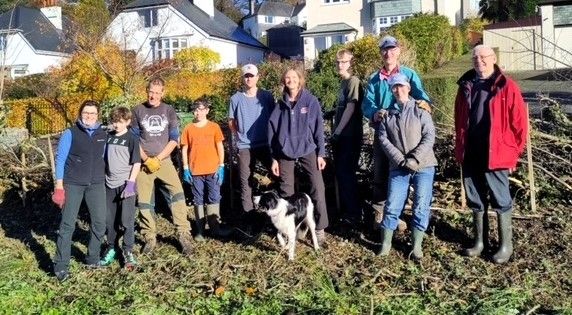
Volunteers laying a hedge at the Springs Road Flood Basin in Keswick had to field some complaints from passers-by who were concerned about the work.
Their eyebrows were raised at the intensity of the hedge thinning and some people raised concerns which were allayed by those carrying out the traditional craft.
Sustainable Keswick’s Joe Human said the fact that there had been complaints had been raised at a meeting of the group and he told The Keswick Reminder: “People don’t understand what is happening, never having seen a hedge being laid before. That is what happens when hedges are laid. The hedge will not look right until it starts to grow in the spring.
“In the past, in winter, hedges were laid on farms and this was a winter job. Hedges are now cut with mechanical cutters. You don’t see much hedge laying going on.”
Members of Sustainable Keswick were supported by Pete Leeson, of the Woodland Trust. The land is owned by Cumberland Council and its primary function is a flood basin.
However, Sustainable Keswick is working with the council to turn the space into a haven for wildlife by planting trees, wild flowers and by carrying out specific tasks like hedge laying.
The event was attended by around 20 volunteers of all ages, helping to bring the community of Keswick together whilst also teaching people new skills.
Hedge laying is a traditional method of managing hedges which pre-dates machinery and metal fencing.
The idea is that a thorny bush, like a hawthorn or blackthorn, if laid on its side with other plants, can create a barrier preventing the movement of stock.
A bush that is growing upright in a hedge is cut – usually with a bill hook (a small axe like tool) – and then laid down towards the ground.
Its neighbour is laid on top of it and bound in to create a really thick impenetrable hedge. In spring the plants bud and new growth comes up through the laid hedge adding a further layer of knitting.
As the number of labourers on farms has reduced and machinery increased this historic practice has become rarer. It is, however, still practised and there are government grants available for farmers to lay hedges if they want to.
Historically, small fields would have been surrounded by laid hedges and one of the winter jobs on a farm would be to lay a new section of hedge each year on rotation. The hedge could be a wonderful source of firewood and other material used about the farm.
Hedges which are managed in this way provide great habitat for birds, insects, mice and hedgehogs and are brilliant for mosses lichens and fungi too.
Mr Leeson teaches the Midland Style of hedge laying with the plants cut and left at an angle of about 30 degrees.
“I like to see more material left in the hedge so that it is immediately ready for birds to hide in the winter and nest in the spring,” he said. “I think it looks prettier too.”








